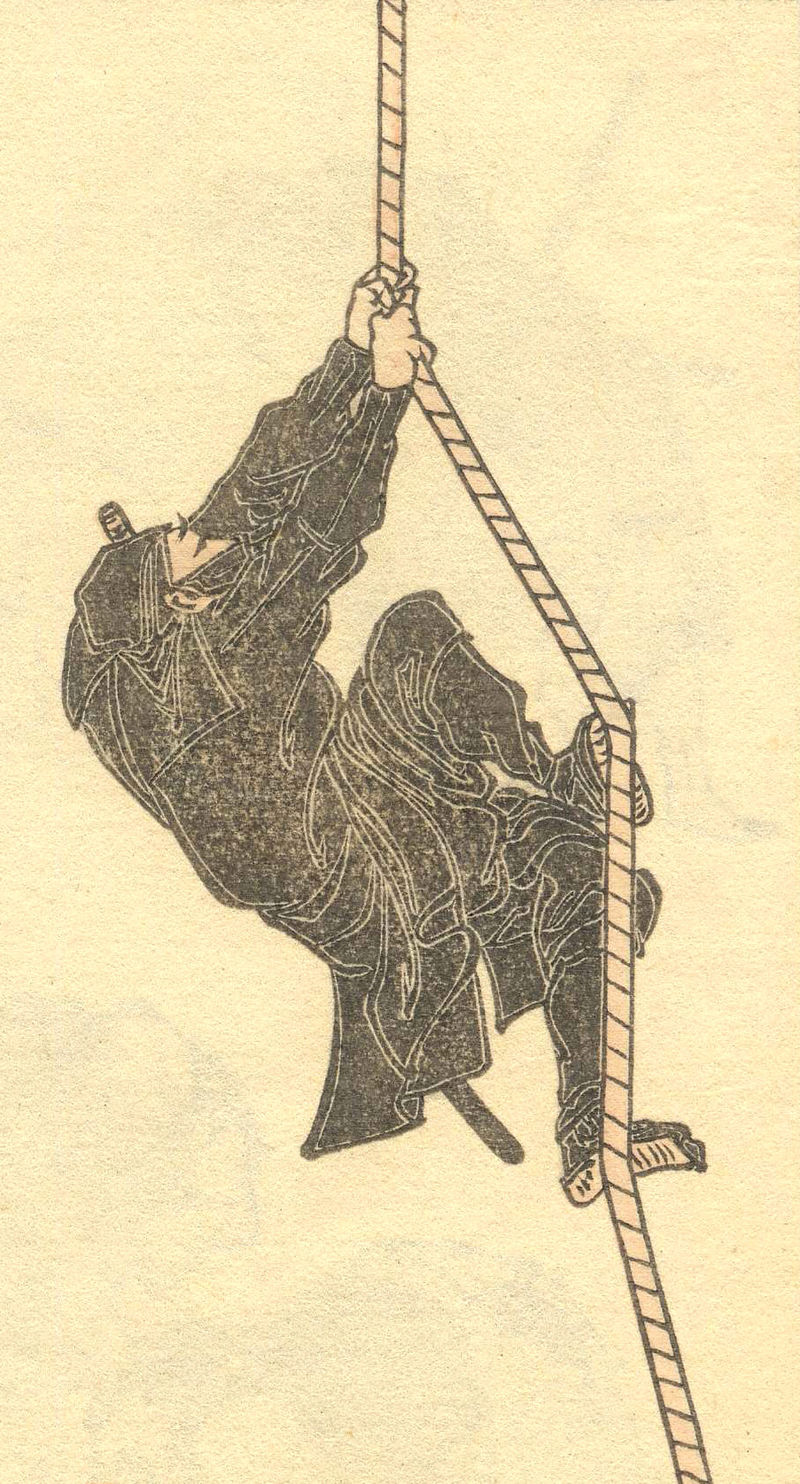

1. SUBCLASS = Thief (Assassin)
2. SOCIAL CLASS MINIMUM
=
3. ABILITY SCORE MINIMUMS
STRENGTH
=
INTELLIGENCE
=
WISDOM
=
DEXTERITY
=
CONSTITUTION
=
CHARISMA
=
COMELINESS
=
4. POSSIBLE RACES &
MAX. LEVEL ATTAINABLE =
5. MULTI-CLASS POSSIBILITIES
=
6. HIT DIE TYPE =
7. MAXIMUM NUMBER OF HIT
DICE =
8. SPELL ABILITY =
9. ARMOR PERMITTED =
10. SHIELD PERMITTED =
11. WEAPONS PERMITTED =
12. OIL PERMITTED =
13. POISON PERMITTED =
14. ALIGNMENT = N
15. STARTING MONEY =
16. WEAPON PROFICIENCIES
=
17. NON-PROFICIENCY PENALTY
=
18. NON-WEAPON PROFICIENCIES
=
19. STARTING AGE =
20. COMBAT = fighter
21. SAVING THROWS = fighter
22. MAGIC ITEMS = fighter,
samurai, thief
In
recent weeks, we have received a number of requests for more
detailed and developed
information to include in campaigns. Here it is,
the DM's "hit-man". Got
a crew of too-powerful PC's? Let a couple
of Ninja show up, and
they'll be happily bumping off each other in no
time. Have another NPC
that has a score to settle with one or more
PC's? Let him hire a
Ninja, or two. If a PC defeats a Ninja, it could become
a matter of clan honor.
And so on, and so on, etc.
Have
fun with this one. A word of caution -- these are bad dudes.
Don't go overboard. This
was originally submitted as a PC; it was far
too powerful for that.
The ninja
was
a semi-mythical charcter in medieval Japan. He
was feared not because he
was terrifying, but rather because he was an
unknown. He could do things
which the people considered inhuman because of
his special tools and training.
The ninja
should not be an automatic character of terror in the
game. While ninja did perform
assassinations that was by no means all
that they did. There is
no reason why a ninja can not cooperate with
lawful and good characters
in the game. He does have much to offer.
These
rules for ninja were based on the book The Art of Invisibility:
Ninjutsu by Donn
Draeger. The book was published in 1971 by
Simpson -- Doyle & Company;
Shibuya P.O. Box 235; Shibuya-ku,
Tokyo, Japan.
The ninja
were grouped in families with a Jonin as family head.
Some jonin were heads of
more than one family. Ninja had three
ranks. Jonin were the family
heads. Genin were the normal field operatives
who performed missions.
Chunin
were the middlemen who
handled Jonin-Genin contacts
and assigned missions. The genin loved
to operate in bad weather.
Ninja
are a special oriental subclass of assassin. They are a combination
of samurai, monk, thief,
and assassin. They have trained since
youth to master their art
of ninjutsu. They are knowledgeable about
poisons, are masters of
disguise, have a virtually perfect sense of balance.
have excellent night vision,
and are very nimble.
Ninja are nonpsychic.
Alignment:
The alignment of a ninja is strict neutrality. This
means that rather than worrying
about grand cosmic balances, a ninja
is interested only in what
is good for himself. This makes it virtually
impossible for a ninja to
change alignment. Ninja are incorruptible in
matters of alignment.
In all
encounters there is an automatic 20% chance that the being
or thing encountered will
consider the ninja to be of its own alignment.
There is no penalty if this
does not result, the ninja will be treated as if
he were neutral for determining
the character of the alignment. This
applies for both beings
or things such as swords. A ninja is able to
simultaneously use, with
no drawbacks if he makes the right rolls,
swords of law, neutrality,
and
chaos. The probability is generated only
once for each encounter.
It is not generated each time something such
as a sword is touched. The
effects of this generation are permanent and
are not altered by
later events.
Languages:
A ninja may know a number of languages equal to his
intelligence -- 6. They
share a secret language. They may learn, if they
wish, the languages of law,
neutrality, and chaos.
Nonhuman and female ninja do exist though they are rare.
A ninja
may not be multiprofessional. There is no limit by race as
to how high a ninja may
rise. No ninja may be higher than 16th level.
Abilities:
A ninja has very good night vision. At first level a ninja
gains the ability to see
clearly up to 30 feet away. At sixth level a ninja
gains the ability to see
clearly up to 60 feet away.
A ninja
is very hard to surprise because of his intensive training. A
ninja is surprised as are
monks.
Ninjas
are also very good at tracking down their victims. A ninja
tracks as a ranger does
with a 20% penalty.
A ninja is able to simulate
death — lowering body temperature,
slowing heart beat, and
stopping breathing — for a number of turns
given by (1-6)x(level) +
1.
A ninja of greater than second
level can travel up to 50 miles a day.
A ninja of greater than
sixth level can travel up to 75 miles a day. A
ninja of greater than tenth
level may travel up to 100 miles a day These
distances may be traveled
without unduly tiring the ninja. These speeds
are also subject to some
modifications depending on the nature of the
terrain.
Poisons:
Ninja are very knowledgeable about poisons. A ninja is
able to chemically brew
poisons or neutralize poison broths as an alchemist three levels lower
than the ninja.
Ninja have also studied
the natural poisons available from animals
and plants. He may collect
these to form ninja poisons or neutralize
poison broths. The time
required to do this is not more than one day
and can be done anywhere
rather inconspiciously. The rules for these
poisons are listed below
and are to be used in addition to the rules in
“The Dragon”. Neutralize
poison broths are handled analagously to
these poison rules.
There are two basic types
of poison. There are poisons that kill and
poisons that paralyze (drugs).
These poisons also come in three different rates of effect: instant (1-2
melee rounds), slow (10-60 melee
rounds), and delayed (90-140
melee rounds). The numbers are the delay
before the poison takes
effect.
The paralyze poisons produce
an inability to move. Kill poisons
produce 0-5 in damage for
each level of strength. The poison may kill
either by accumulation of
levels or by accumulation of damage. Neutralize poison removes both the
poison and the damage it caused. If a
character is hit by an accumulation
of double his level in paralyze poisons he dies through suffocation. A
kill poison produces only half
damage if the saving throw
is made.
As a ninja advances in experience
his ability to collect natural poisons grows. At the level of chigo the
ninja knows how to make a level
one poison of one of the
six types. Every time the ninja advances a level
he gains the ability to
make another level of poison. The poison
strength that may be made
may not be larger than the number of levels
selected for that poison.
At level six the ninja must
be able to make three different types of
poison. At level 12 the
ninja must be able to make all six types of poison of at least strength
one. The three poison types used at level six
must be of at least strength
two.
Ninja poison may be made
either fluid or viscous at the ninja’s
discretion. Viscous poison
is used on weapons and is used as per blade
venom for coverage. The
poison evaporates rapidly being gone in about
12 hours after being applied.
Fluid poison is used to poison food and
drink. When the poison is
used in either form there is a 20% chance
that it will be noticed.
The ability to handle neutralize
poison broths is handled in the
same way as the ability
to make poisons. No saving throw is needed
against neutralization brews.
A paralization cure neutralizes one level
for every level of the brew.
A kill neutralization cures 0-5 from poison
damage and removes one kill
level of accumulation. A cure brew is
most effective against the
poison it is designed for. It is of half effect
against the other two rates
of onset poisons and alchemist poisons.
Paralization and kill cures
do not affect each other. Kill if of no effect
against paralyze and visa
versa.
Fighting:
Ninja do not like to wear armor. They will refuse to wear
plate, but some have been
known in emergencies to wear chain or
leather. Note that a ninja
will not like chain because it is noisy. The
only special armor they
really use is their special shield, the neru-kuwa
ito.
A ninja advances in combat
steps as a fighter. A ninja has the combat adds of a fighter.
They may attack open-handed
as a monk.
They may use judo as a samurai.
The ninja’s nimbleness allows
him to evade fighting damage. In a
fight give the ninja a saving
throw against all missile, melee, and directed spell damage. They save
as a magician of one level higher versus
spells. Hobbits and dwarves
do not add four levels.
A directed spell is a spell
such as a thin lightning bolt.
It is not an
area spell such as sleep
or fireball. The basic idea is whether the spell is
directed at the ninja or
the large area of ground the ninja is on. This
same saving throw is granted
against area spells if the ninja is on the
fringe of the affected area.
If the special save is not made proceed as
for normal characters. If
the save is made no damage results.
A ninja knows how to use
all weapons. However they have a -3 on
attack rolls applied against
them at all levels. This penalty is removed in
two special cases and is
removed weapon by weapon. The penalty applies against ninja weapons that
have not yet been mastered. The two
special cases are a) the
ninja has mastered the appropriate ninja weapon
or b) the ninja has learned
a disguise class that uses the weapon. Learning a disguise class gives
mastery over all normal weapons the class
uses.
| Disguise class | Weapons reserved to disguise |
| Magician | Dagger and stave |
| Cleric | Mace, hammer, flail, slings, and the like. |
| Druid | Scimitar, sickle, dagger, spears, and sling. |
| Samurai | Katana, wakazashi, and yumi bow |
| Thief | Short sword, dagger, and sap |
| Fighter | Any weapon not listed above |
The -3
penalty is removed only once per weapon even if it is used
by several groups.
Saving
Throws: A ninja saves as a fighter. A ninja takes damage
from books as a fighter
if damage is due.
A ninja is granted a special
save against missiles, melee, and directed spells as detailed above.
Disguises:
Ninja are masters of disguise. Ninja are able to live for
years in a disguise with
no one guessing the truth. A ninja is able to
change disguises with inhuman
speed.
A ninja has a 4% advantage
over an assassin in whether the disguise is recognized. A ninja will wear
armor as part of the disguise
(though he will hate it
and will try to get rid of the armor at first opportunity — GM’s please
note!).
A ninja gains the ability
to form disguises as he advances in experience. The ninja will not only
look like what the disguise is, but he
will be able to perform
the correct social mannerisms.
As the ninja gains disguise
classes they are drawn from the following list:
Disguise List
1. Fighter: basic low level
2. Cleric: basic low level
3. Magician: basic low level
4. Thief: basic low level
5. Artisan
6. Theatrical artist
7. Merchant
8. Farmer
9. Special: must have chosen
at least three from #‘s 1-8, this is a
disguise of the character’s
invention. This also includes subclasses.
10. Nobility: must have
at least five choices from #‘s 1-9, this disguise is higher level types.
Magic:
A ninja may use anything that a fighter, samurai, or thief
is allowed to use.
Detection
of Ninja: as most of the ninjutsu consists of trained reflexes, it
is possible for these reflexes to cause him to betray himself.
This should be done at the
discretion of the gamemaster.
If a gamemaster should decide
that this has happened, he should
never simply say “He is
a ninja.” Instead he should say something
more like “He avoided that
rock (or oxcart or whatever) very nimbly.”
It should be done this way
to avoid having players throw rocks at
everyone they meet!
As the ninja advances he
learns to use the tools of this trade. These
are weapons(W), disguises(D),
ninja tools(T), and ninja equipment(E).
The numbers in the table
represent the number of draws in each category gained on reaching a level
| Level | Title | Hit Dice | Save vs Damage | W | D | T | E |
| 0 | Chigo | 1D4 | 15 | * | * | * | * |
| 1 | Bushi | 1D6 | 15 | Basic Kit | Basic Kit | Basic Kit | Basic Kit |
| 2 | Genin | 2D6 | 15 | 1 | 0 | 1 | 1 |
| 3 | Genin | 3D6 | 15 | 0 | 0 | 0 | 1 |
| 4 | Genin | 4D6 | 15 | 1 | 1 | 0 | 1 |
| 5 | Genin | 5D6 | 12 | 0 | 1 | 1 | 1 |
| 6 | Chunin | 6D6 | 12 | 1 | 0 | 1 | 1 |
| 7 | Chunin | 7D6 | 12 | 1 | 1 | 0 | 1 |
| 8 | Chunin | 7D8 | 12 | 1 | 0 | 1 | 1 |
| 9 | Chunin | 10D6 | 12 | 1 | 1 | 0 | 1 |
| 10 | Jonin | 9D8 | 8 | 1 | 1 | 1 | 1 |
| 11 | Jonin | 6D12+ 1D8 | 8 | 1 | 1 | 0 | 0 |
| 12 | Jonin | 6D12+ 2D8 | 8 | 1 | 1 | 0 | 0 |
| 13 | Jonin | 7D12+ 1D8 | 8 | 1 | 1 | 0 | 0 |
| 14 | Jonin | 8D12 | 8 | 1 | 1 | 0 | 0 |
| 15 | Jonin | 8D12+ 1D4 | 3 | 1 | 1 | 0 | 0 |
| 16 | Jonin | 8D12+ 2D4 | 3 | 0 | 1 | 0 | 0 |
There are no ninja levels
higher than level 16. Any ninja may advance to that level.
Ninja families are each
headed by one jonin. The same person may
be jonin to more than one
family.
The numbers under W, D, T,
and E are the number of draws the
ninja takes upon reaching
that level. These skills are gained immediately upon advancing in level.
A ninja may teach any ninja skill or
knowledge to another ninja
for a proper price. The time required per
item taught should be at
least one month.
Ninja are close mouthed about
ninja secrets. They have been conditioned so that they will usually die
before revealing ninja secrets, even
when charmed. The ninja
may of course attempt to lie when questioned. Extraordinary means are required
to gain such information
even when the questioner
is a close friend of the ninja. Ninja do not
talk in their sleep.
Ninja are as a rule secretive.
This means that they will not usually
tell people that they are
ninja. This means that ninja weapons, tools,
and equipment are not as
a rule available for purchase. When these
items are they are considered
to be curios, possibly valuable ones. Nonninja will not be able to easily
recognize them or use them properly in a
fight (-3 on attack rolls,
-2 on damage rolls). This penalty applies no
matter how much time is
spent in an attempt at mastery.
A ninja must therefore make
his own gear or modify available
items. A ninja has this
skill to make any ninja item that he has mastered.
The basic kit of a ninja
consists of the following items: the ninja-to
(his sword), sageo
(a belt used in wearing the saya, also used as a rope
and garrote), saya
(his scabbard), the tetsu-bishi (calthrops), the tool
osaku (a lockpick),
one choice of disguise, and one choice of equipment.
Ninja
skills at thievery:
A ninja acts as a thief three levels below
him. This is tabulated below
including some special bonuses.
| Character
type |
Pick lock | Remove trap | Pick-pocket | Move silent | Hide in shadows | Hear Noise |
| human | 0 | 0 | 0 | 0 | 0 | 0 |
| elf | 0 | 0 | 5 | 10 | 15 | 0 |
| dwarf | 5 | 15 | 0 | 5 | 5 | 0 |
| hobbit | 10 | 5 | 5 | 10 | 10 | 15 |
| female | 5 | 5 | 5 | 5 | 5 | 5 |
These bonuses are all additive.
Percent chance of success with skill
| Ninja level | Pick lock | Remove-trap | Pick pocket | Move silent | Hide in shadows | Hear Noise | Fall off walls |
| 0 | -5 | -10 | 0 | 20 | 30 | 20 | 15 |
| 1 | 0 | -5 | 5 | 40 | 40 | 50 | 14 |
| 2 | 5 | 0 | 10 | 45 | 45 | 58 | 13 |
| 3 | 10 | 5 | 15 | 50 | 50 | 67 | 12 |
| 4 | 15 | 10 | 20 | 55 | <??> | 70 | 11 |
| 5 | 20 | 15 | 25 | 60 | 60 | 73 | 10 |
| 6 | 25 | 20 | 30 | 65 | 65 | 77 | 9 |
| 7 | 35 | 30 | 35 | 70 | 70 | 80 | 8 |
| 8 | 40 | 35 | 45 | 75 | 75 | 83 | 7 |
| 9 | 45 | 40 | 55 | 80 | 80 | 88 | 6 |
| 10 | 55 | 50 | 60 | 90 | 90 | 94 | 5 |
| 11 | 65 | 60 | 65 | 95 | 95 | 100 | 4 |
| 12 | 75 | 70 | 75 | 100 | 100 | 104 | 3 |
| 13 | 85 | 80 | 85 | 105 | 105 | 108 | 2 |
| 14 | 95 | 90 | 95 | 110 | 110 | 112 | 1 |
| 15 | 100 | 95 | 100 | 115 | 115 | 117 | 0 |
| 16 | 105 | 100 | 105 | 120 | 120 | 121 | -1 |
The table is used as follows.
Generate a number 1-100 and compare the number generated to the table entry
below.
| Table entry | Number generated | Result |
| 1-100 | Less than entry | attempt is successful |
| 1-100 | Greater than or equal to entry | attempt fails and may not be repeated |
| 100+ | 1-99 | attempt is successful |
| 100+ | 100 or greater | subtract 100 from the entry and repeat procedure |
A ninja falls from walls
as a monk. He is able to climb the sheerest
of walls with his tools.
A ninja scores the multiple
damage of a thief one level higher than
he is.
Assassination:
A ninja operates as an assassin two levels higher
than his own.
The probability of a ninja
succeeding at an assassination is listed in
the table below along with
the cost of hiring a ninja. The units of price
used is “K” which equals
1000 gold pieces.
A ninja pays 15% of his
fee to the jonin of his family. As a chigo
does not have a family he
does not have to divide his fee. A ninja earns
experience for an assassination
as an assassin.
Special
Ninja Devices: A ninja gains the ability to manufacture the
tools of his trade when
he masters their use. All ninja devices are as a
general rule concealable.
They will not in general be recognized as the
professional tools they
are to non-ninja. The prices listed in parentheses
are suggested costs of manufacture
for the ninja in their manufacture.
Assassination Probability
Percent Chance of Success
Level of Victim
| level | cost | 1 | 2 | 3 | 4 | 5 | 6 | 7 | 8 | 9-11 | 12-14 | 15+ |
| 0 | 1 K | 50 | 45 | 40 | 30 | 20 | 5 | * | 1 | 1 | 1 | * |
| 1 | 1.5 K | 85 | 80 | 75 | 65 | 55 | 40 | 25 | 10 | 1 | * | * |
| 2 | 2 K | 90 | 85 | 80 | 70 | 60 | 45 | 30 | 15 | 1 | * | 1 |
| 3 | 2.5 K | 95 | 90 | 85 | 75 | 65 | 50 | 35 | 20 | 5 | * | 1 |
| 4 | 3 K | 100 | 95 | 90 | 80 | 70 | 55 | 40 | 25 | 10 | 1 | 1 |
| 5 | 3.5 K | 100 | 100 | 100 | 85 | 75 | 60 | 45 | 30 | 15 | 1 | * |
| 6 | 4 K | 105 | 100 | 100 | 90 | 80 | 65 | 50 | 35 | 20 | 5 | * |
| 7 | 8 K | 105 | 105 | 105 | 95 | 85 | 70 | 55 | 45 | 25 | 10 | 1 |
| 8 | 16 K | 105 | 105 | 105 | 100 | 90 | 75 | 60 | 45 | 30 | 15 | 1 |
| 9 | 32 K | 110 | 105 | 105 | 100 | 95 | 80 | 65 | 50 | 35 | 20 | 5 |
| 10 | 64 K | 110 | 110 | 110 | 105 | 100 | 85 | 70 | 55 | 40 | 25 | 10 |
| 11 | 128 K | 110 | 110 | 110 | 105 | 100 | 90 | 75 | 60 | 45 | 30 | 35 |
| 12 | 256 K | 115 | 110 | 110 | 105 | 105 | 99 | 95 | 80 | 65 | 50 | 35 |
| 13 | 512 K | 115 | 115 | 110 | 110 | 105 | <110> | 100 | 90 | 75 | 60 | 45 |
| 14 | 1006 K | 115 | 115 | 115 | 110 | 105 | 100 | 100 | 95 | 85 | 80 | 75 |
| 15 | 1518 K | 120 | 115 | 115 | 110 | 110 | 100 | 100 | 99 | 95 | 85 | 80 |
| 16 | 2012 K | 120 | 120 | 115 | 115 | 110 | 105 | 105 | 100 | 100 | 90 | 85 |
Ninja weapons
(costs in gold)
1) Bo staff (0)
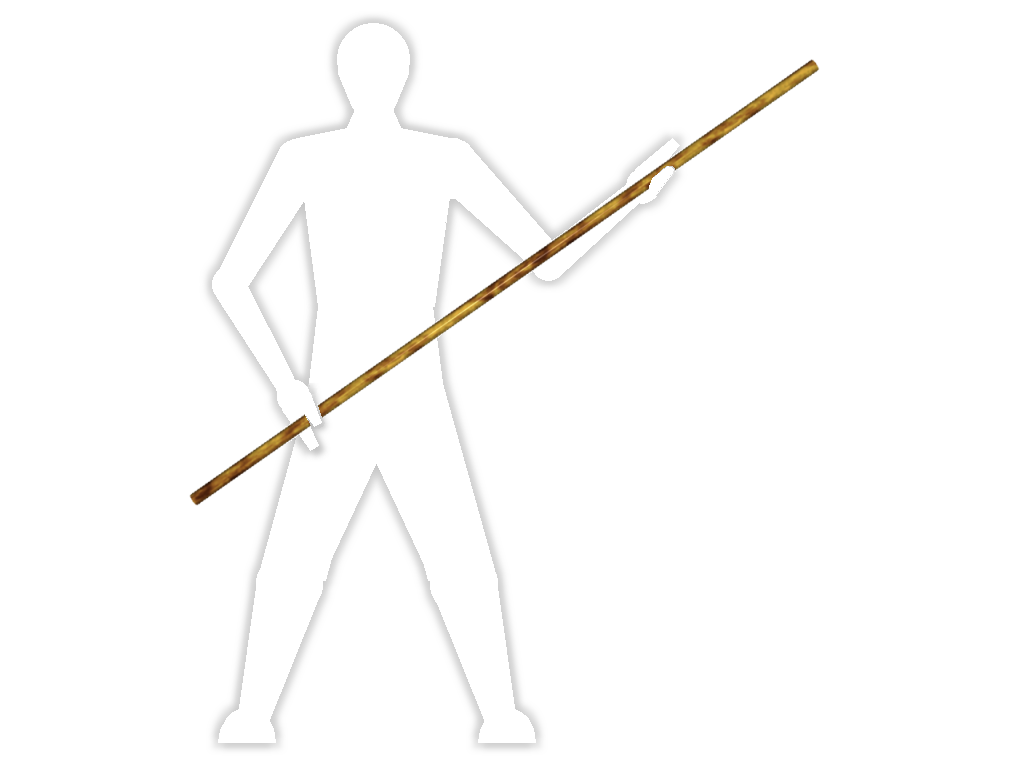
This is the basic quarterstaff.
The selection of this weapon gives
mastery in a fight over
all staves.
2) Ninja-to (10: cost of basic short sword)
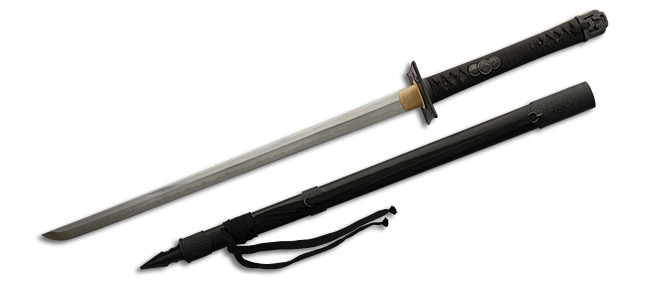
This is the ninja’s short
sword. It is not a particularly fine sword and
should be treated as an
ordinary sword.
3) Sageo (.1)
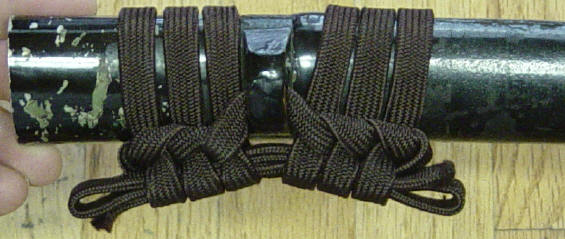
This is the belt or cord
used to wear the sword’s scabbard. It was a long
cord that is also used as
a rope or garrote.
4) Nage teppo (20 gold and
one week to make 2-8)
These are small grenades
made by filling empty eggshells. Treat these as
an alchemist’s flash pellets.
5) Sode tsutsu (50 gold and
one week)
This is a crude one shot
shotgun. It fires a triangular shaped cone of
projectiles up to 30 feet
away and 10 feet across at the base. Treat it as
an arquebus for hitting.
It causes 3-24 in damage when it hits. Allow a
saving throw versus death
for half damage.
6) Kakae ozutsu (50 gold and one week)
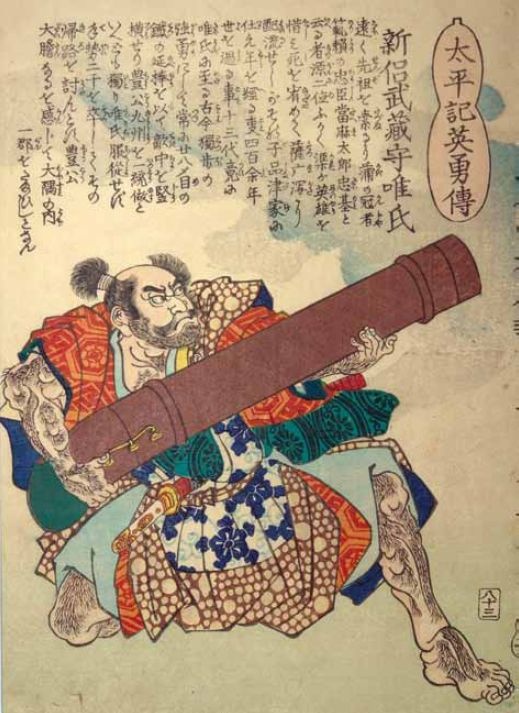
This is a crude large barreled
one shot high trajectory mortar made
from wood and paper. It
has a minimum range of 30 feet and a maximum range of 90 feet. Treat it
as a long bow for purposes of hitting. If
it misses the gamesmaster
should determine where the projectile went.
The projectile will burst
in a 10 foot blast radius. All within the blast
radius take 1-20 in damage.
Allow a saving throw versus death for half
damage.
7) Uzume-bi (20 gold and
3 days to make one)
This is a land mine that
bursts when stepped upon. It has a 5 foot blast
radius. The blast causes
1-10 in damage. Allow a saving throw as for
the sode tsutsu and kakae
ozutsu to see if half damage results.
8) Hankyu (30 gold and one
week)
This is a special bow that
fires arrows, fire bombs, and/or other incendiaries. Treat it as a short
bow for hitting. It has a maximum range of
150 feet.
9) Metsubushi (5 gold and
2 weeks, 5 gold and one week to make
5 darts)
This is a blowpipe. It fires
poison darts called fukiya silently at a rate of
one every other melee round.
The darts cause 1-2 in damage and deliver
poison. The maximum range
is 30 feet.
10) Tetsu-bishi (15 gold and 4 days to make 2)
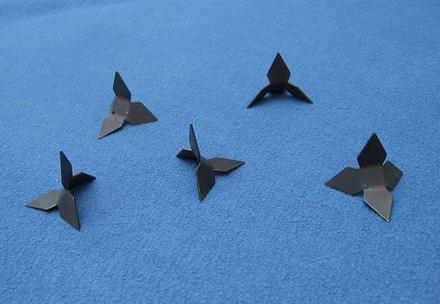
These are caltrops. They
may be poisoned. They were commonly left
on the ground in a pattern
the ninja knew over his route of retreat.
These may be sold in shops.
11) Kusarigama (7 gold, 1 week)
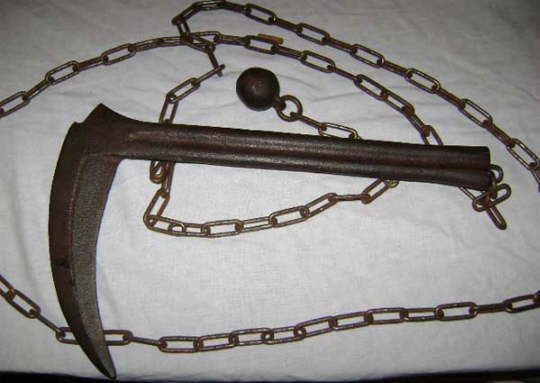
This weapon looks like a
scythe with a chain attached to the base of the
weapon. The chain is used
as a flail. The weapon may be used in four
different attack modes.
scythe:
This is used one handed using the scythe blade.
flail:
This is used one handed as a flail.
combo:
The weapon is held two handed and gives two attacks each melee round without
penalty. One attack as a scythe and one attack as a flail.
special:
The chain may be used to entangle the enemy’s
weapon.
This attack has a penalty of -4 on the flail attack.
12) Kyoketsu shoge (4 gold, one week)
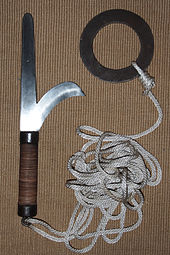
This is a one handed weapon
that looks like the kusarigama with the
chain replaced by a piece
of rope. It may be used as a scythe. It may be
thrown as a hand axe. The
rope may be used to entangle the enemy’s
hands (it uses speed and
the enemy’s reflexes against him). When he
was entangled he could be
pulled helplessly to short range and finished
off.
13) Shinobi zue (6 gold and 4 days)
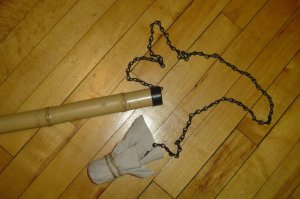
This is a staff with a concealed
flail. It is used with two attack modes.
One attack as a staff and
one attack as a flail. The flail attack does not
have to be used if the ninja
wishes to keep the flail secret. Both attacks
may be used in one melee
round with no penalties.
14) Fukumi-bari (1 silver,
no time)
Some ninja were able to
spit poisoned needles called fukumi-bari out of
their mouths at their enemies.
They could even do this without injuring
themselves. A ninja may
spit two needles a melee round up to 15 feet. A
maximum of five needles
may be held in the mouth at one time. If a
needle hits there is a 50%
chance that it poisoned the target, else no
effect.
15) Shuriken (3 gold, 3 days
for one)
The shuriken is the ninja’s
main throwing weapon. Normally nine of
these are carried for nine
is considered to be a lucky number. Shuriken
are often stuck into the
ground with the blades up to deter pursuit.
Placed in the ground this
way they are very hard to see.
There are three basic kinds
of shuriken. Each kind counts as a
separate choice of ninja
weapon. These three kinds are denoted as dart,
star and whistler shuriken.
One shuriken may be thrown
each melee round for every two levels
the ninja has attained.
This multiple throw may be made without
penalty. Shuriken are easily
concealed under robes and by clothing.
Concealed shuriken may,
however, be reached as easily as unconcealed
shuriken and used without
penalty.
Shuriken have an extra penalty
of -1 on attack when they face
shields.
Shuriken have a maximum
range of 30 feet.
a. Dart Shuriken

These shuriken resemble long
nails. They attack as a + 2 dagger. When
they are used against chain
the chain is considered to give protection
equal to leather. The shuriken
slips between the links of the chain and is
slowed only by the padding
underneath which is set equal to leather.
The shuriken does a basic
1-6 against a man-sized target.
b. Star Shuriken
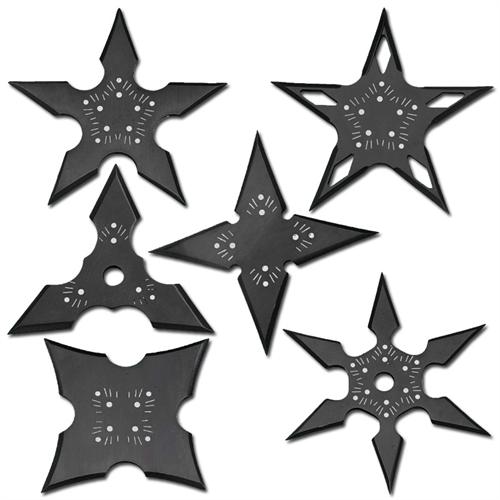
These are the standard star
shaped shuriken of legend. The many
blades on the shuriken gives
a much greater chance to hit than a dagger.
The attack modifiers are
listed below. The shuriken does a basic 1-4
against man-sized targets,
the same as a dagger.
c. Whistler Shuriken
These shuriken are a further
modification of the star shuriken. They
are shaped as a star shuriken
with a hole in the center. The hole in the
center causes a terrifying
sound when it is hauled. For this all in the
target area save versus
fear with +2 on their die roll. Do not give the
+ 2 if they are surprised
or did not expect the noise. For combat purposes for damage and attack
odds treat these the same as star shuriken.
The hole changes the weight
of the shuriken enough to make mastery
count as a separate weapon.
The hole was also useful as a nail puller.
EFFECTS OF NINJA WEAPONS
| Weapon | Man-sized | Expert | Larger than
man-sized |
Expert |
| Bo staff | 1-8 | 1-10 | 1-6 | 1-8 |
| Ninja-to | 1-8 | 1-10 | 1-12 | (1-8)+(1-6) |
| Sageo | 1-6/round | 1-8/round | 1-6/round | 1-8/round |
| Kusarigama | - | - | - | - |
| sycthe | 1-6 | 1-8 | 1-10 | 1-12 |
| chain | 8 | 10 | 8 | 10 |
| special | *** | *** | *** | *** |
| Kyoketsu shoge | - | - | - | - |
| scythe | 1-6 | 1-8 | 1-10 | 1-12 |
| rope | **** | **** | **** | **** |
| Shinobe zue | - | - | - | - |
| staff | 1-6 | 1-8 | 1-6 | 1-8 |
| flail | 1-8 | 1-10 | 1-8 | 1-10 |
| Nekode | 2-5 | 1-6 | 0-3 | 1-4 |
| Sode tsutsu | 3-24* | 3-24* | 3-24* | 3-24* |
| Kakae ozitsu | 1-20* | 1-20* | 1-20* | 1-20* |
| Uzume-bi | 1-10* | 1-10* | 1-10* | 1-10* |
| Tetsu-bishi | 1-4 | 1-4 | 1-6 | 1-6 |
| Hankyu | 6 | 6 | 6 | 6 |
| Metsubishi | 1-2***** | 1-2***** | 1-2***** | 1-2***** |
| Kyoketsu shoge | 6 | 8 | 4 | 6 |
| Fukumi-bari | ** | ** | ** | ** |
| Dart-shuriken | 1-6 | 2-7 | 1-4 | 2-5 |
| Star shuriken | 1-4 | 2-5 | 1-3 | 2-4 |
| Whistler shuriken | - | - | - | - |
* save vs. damage
** 50% to poison
*** entangle the enemy's
weapon
**** entangle the enemies
hands
***** plus poison
<>
The
entries of save vs. damage mean to make a saving throw versus
death or poison. If the
saving throw is successful half damage results.
NINJA HAND WEAPONS
Armor Class
| Weapon | 2 | 3 | 4 | 5 | 6 | 7 | 8 | 9 |
| Bo staff | -3 | -3 | -2 | 0 | 0 | 3 | 1 | 2 |
| Ninja-to | -2 | -1 | 0 | 0 | 0 | 0 | 0 | 1 |
| Sageo | -3 | -3 | -2 | -2 | -1 | -1 | 0 | 0 |
| Kusarigama | - | - | - | - | - | - | - | - |
| scythe | -1 | 0 | 1 | 1 | 1 | 1 | 1 | 2 |
| chain | 2 | 2 | 1 | 2 | 1 | 1 | 1 | 1 |
| special | -2 | -2 | -3 | -2 | -3 | -3 | -3 | -3 |
| Kyoketsu shoge | - | - | - | - | - | - | - | - |
| scythe | -1 | 0 | 1 | 1 | 1 | 1 | 1 | 2 |
| rope | 0 | 0 | 0 | 0 | 0 | 0 | 0 | 0 |
| Shinobe zue | - | - | - | - | - | - | - | - |
| staff | -3 | -3 | -1 | 0 | 0 | 2 | 1 | <?> |
| flail | 2 | 2 | 1 | 2 | 1 | 1 | 1 | <?> |
| Nekade | -3 | -2 | -2 | -1 | 0 | 1 | 0 | <?> |
NINJA MISSILE WEAPONS
Armor Class
| Weapon | 2 | 3 | 4 | 5 | 6 | 7 | 8 | 9 |
| Sode tsutsa (30 feet) | 0 | 1 | 2 | 2 | 3 | 3 | 3 | 3 |
| - | -1 | 0 | 0 | 1 | 2 | 2 | 2 | 2 |
| - | -3 | -1 | 0 | 0 | 0 | 0 | 0 | 0 |
| Kakae ozitsu (90 ft) | * | * | * | * | * | * | * | * |
| - | -3 | -2 | 0 | 1 | 2 | 2 | 2 | 2 |
| - | -5 | -4 | -1 | 0 | 1 | 1 | 1 | 1 |
| Hankyu (150 ft) | -3 | -2 | 0 | 0 | 1 | 2 | 2 | 2 |
| - | -5 | -3 | -1 | 0 | 0 | 1 | 1 | 1 |
| - | -7 | -5 | -2 | -1 | 0 | 0 | 0 | 0 |
| Metsubishi (30 feet) | -3 | -2 | 0 | 0 | 1 | 2 | 1 | 3 |
| - | -5 | -3 | -1 | -1 | 0 | 1 | 1 | 2 |
| - | -7 | -5 | -4 | -3 | 0 | 0 | 0 | 0 |
| Kyoketsu shoge (45 feet) | -4 | -3 | -2 | -2 | -1 | -1 | 0 | 0 |
| - | -5 | -4 | -3 | -3 | -2 | -2 | -1 | -1 |
| -- | -6 | -5 | -4 | -4 | -3 | -3 | -2 | -2 |
| Fukumi-bari (15 ft) | -1 | 0 | 2 | 3 | 2 | 3 | 3 | 5 |
| - | -2 | -1 | 1 | 2 | 1 | 2 | 2 | 4 |
| - | -3 | -2 | 0 | 1 | 0 | 1 | 1 | 3 |
| Dart shuriken (30 ft) | -1 | -1 | 1 | 1 | 2 | 2 | 3 | 4 |
| - | -2 | -2 | 0 | 0 | 1 | 1 | 2 | 3 |
| - | -3 | -3 | -1 | -1 | 0 | 0 | 1 | 2 |
| Star, whistler shuriken (30 ft) | -2 | -1 | 3 | 3 | 5 | 5 | 6 | 6 |
| - | -3 | -2 | 2 | 2 | 4 | 4 | 5 | 5 |
| - | -4 | -3 | 1 | 1 | 3 | 3 | 4 | 4 |
The shuriken have special
modifications against certain types of
armor.
| Armor type | Dart shuriken | Star and Whistler shuriken |
| Shield only | 2/1/0 | 5/4/3 |
| Leather and shield | 1/0/-1 | 4/3/2 |
| Chain | 4/3/2 | 3/2/1 |
| Chain and shield | 3/2/1 | 2/1/0 |
| Plate and shield | -2/-3/-4 | -3/-4/-5 |
Ninja Tools
1) Tsuba (2 gold and one
day)
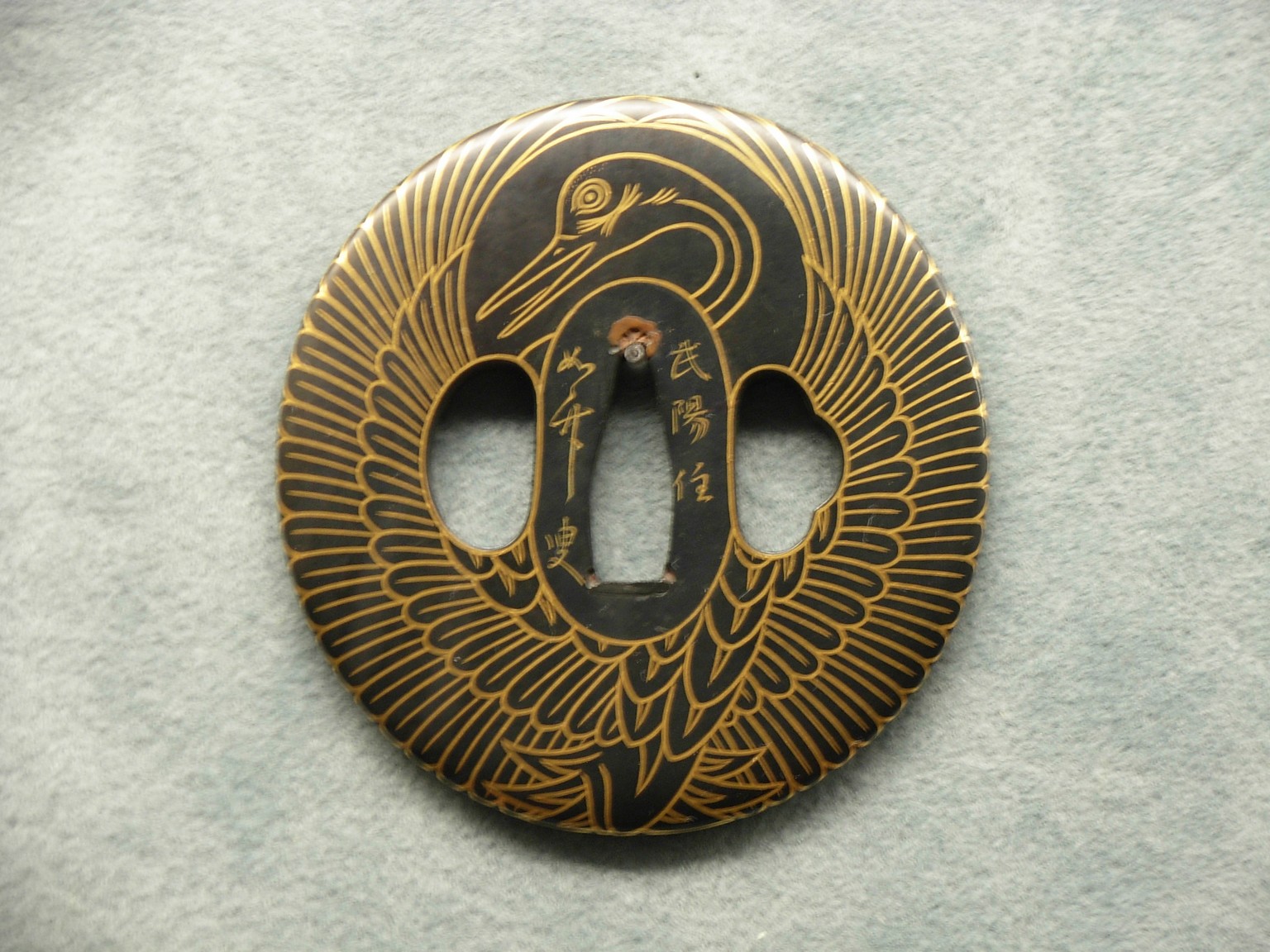
This is the hilt guard of
the ninja-to. The price and time listed is the
modification cost and time
required to modify the hilt-guard on a
standard short sword of
10 gold piece cost. The tsuba was over sized so
that when the ninja-to was
sheathed it could be used as a first step up
something. The long sageo
was then used to recover the sword.
2) Osaku (1 copper, nil time)
This is a lockpick.
3) Tsuba-giri (1 silver,
4 hours)
This is a lever used to
spring doors and cut locks.
4) Shikoro (5 silver, 1 week)
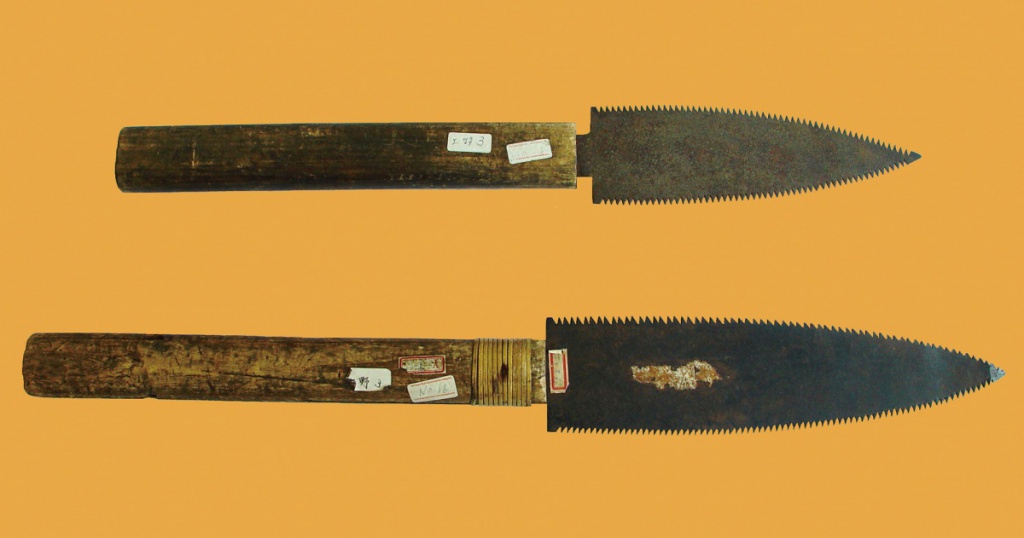
This is a pointed saw that cuts through wood and metal.
5) Kunai (5 silver, nil time)
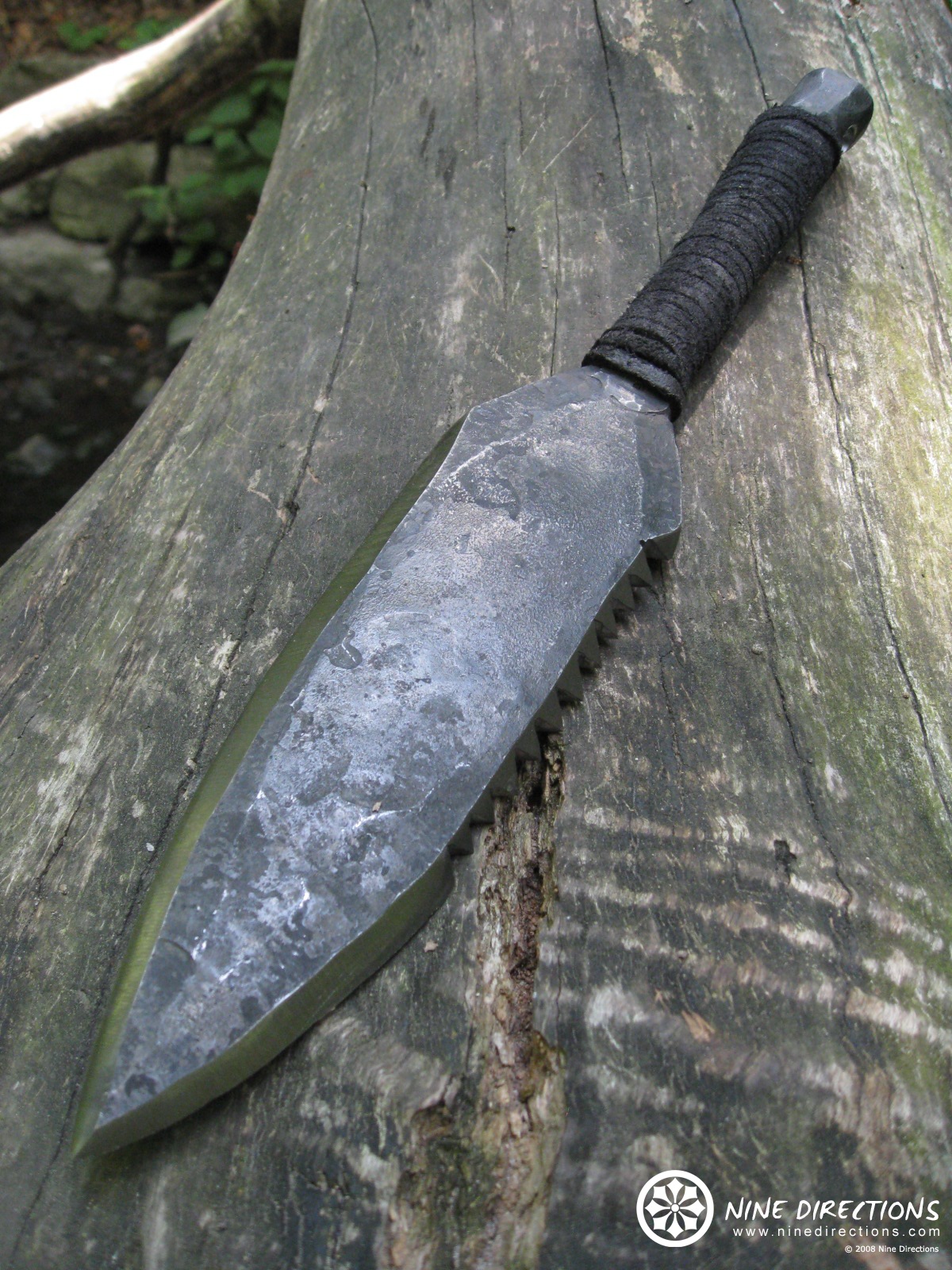
This is a thin spatulate-shaped
knife which is used to dig holes or bore.
Ninja were able to dig holes
very quickly. Some were reported able to
dig faster than a mole.
6) Tatami nomi (5 silver,
1 day)
This is used to chisel out
locks.
7) Escape skill
This gives a ninja the ability
to dislocate his joints voluntarily. This
makes it very difficult
to keep him bound. Allow a 20% chance each
turn the ninja is not under
continuous close watch that the ninja has
slipped free of any bonds.
This is not cumulative and is granted each
turn of effort to escape.
Ninja equipment
1) Saya (nil cost and time)
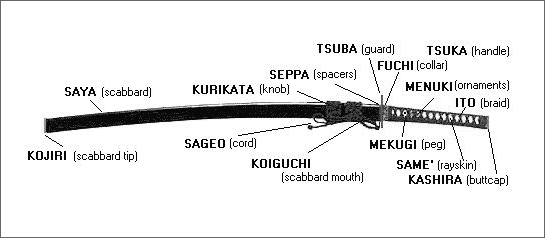
This is the scabbard of the
ninja-to. It is longer than the sword so it is
often used to hide powders
which might then be blown at the enemy. It
is also usable as a snorkel.
2) Shinobi koi (1 silver,
1½ weeks)
This is a bamboo tube that
can be used to conceal a flail.
3) Shinobi kumade (2 gold,
1 day)
This is a concealable and
collapsible 10 foot long climbing pole.
4) Nekade (3 gold and 4 days)
These are also called cat’s
claws. They are constructed similar to brass
knuckles. The knuckles look
like tiny claws and are worn on the inside
of the hand. They are of
some small benefit in hand to hand fighting.
While they are worn the
ninja may neither use judo nor attack open
handed as a monk. They subtract
5% from the chance of falling while
climbing.
5) Mizuzutsu (2 silver, ½
day)
This is a snorkle.
6) Musubinawa (1 gold, 1
week)
This is a light 20 foot
long concealable rope that can hold up to thrice
body weight.
7) Neru-kawa ito (10 gold,
10 days)
This is a thick laminated
leather protective nonmagical shield of special
value to a ninja. It is
a modification of the regular wooden shield. Its
value is listed below:
| Shield action | User action | User type |
| Perfect missile protection | does not move or melee | ninja master of shield |
| +3 shield, add to saves | user moves | ninja master of shield |
| +2 shield as above | user fights | ninja master of shield |
| +3 shield | does not move or fight | ninja non-master of shield |
| +2 shield | user moves | ninja non-master of shield |
| +1 shield | user fights | ninja non-master of shield |
| +1 shield | all cases not described above | - |
8) Kama ikada (5 silver,
1 week)
This is a small, straw,
foldable, and portable one-man raft that can be
carried concealed under
one’s costume!
9) Mizugumo (2 silver, 2 days for two)
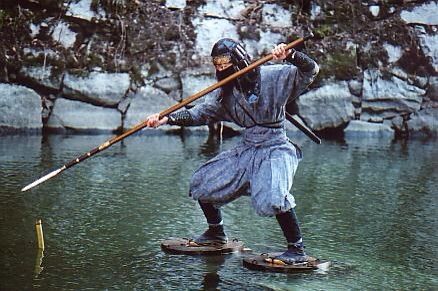
These are also called water-feet.
They are used in pairs. They are
basically rafts designed
to go on each foot. They give the illusion of
walking on water.
10) Ukigusa (2 silver, 3
days)
This is a flotation device.
11) Tablets (10 gold and
one week for 1-6)
A ninja is able to prepare
condensed pellets of food and/or poison. The
food and/or poison is obtained
as normal and is then modified.
THE NEW, IMPROVED
NINJA!
Sheldon Price
| The Ninja | Weaponry | Tools | Equipment | Poisons |
| - | - | Ninja Gear | - | - |
| Dragon 30 | Best of Dragon, vol. II | - | Classes | Dragon |
These rule extensions for
the ninja are based on the book, NINJA:
The Invisible Assassins,
by Andrew Adams, published in 1970 by
O’Hara Publications, Inc.,
Los Angeles, Calif. The rule extensions involve four areas in the ninja
skills: weaponry, tools, equipment, and
poisons.
W
e a p o n r y :
The ninja’s bow is called the hankyu. The bow is very light
with a rapid rate of fire.
The encumbrance weight of the hankyu,
including up to 40 arrows,
should be taken as 20. In the hands of a ninja
skilled in its use (a ninja
who has chosen this weapon), it fires at twice the
rate of a short bow.
The ninja use calthrops which
are called tetsu-bishi. The tetsu-bishi
came in several types: all
formed metal, bent nails, plants, and a mix of
other forms. Long nails
may be inserted into plant matter to form what
looks like a potato with
nails in it. About a dozen nails are used in each
one. This form takes nil
time to make and costs about a silver piece for
the nails to use in one.
Plants can be found that look like natural
calthrops. These have nil
cost. There is a 5% chance for each day spent
searching that 1-6 of these
may be found. The probability is not cumulative. These cause damage the
same as regular formed all-metal tetsubishi.
Metal claws may be attached
to fingers and toes. These sharp claws
may cause serious injury
on penetrating the skin. They may be poisoned. They cost 2 silver pieces
and it takes one week to make a
complete set for hands and
toes.
Female ninja, called kunoichi,
often use a long metal hairpin which
they conceal in their elaborate
hairdos. These pins are usually used by
stealth when the kunoichi
is very close to her target. They are often used
while the kunoichi is in
bed next to her target while her target sleeps.
They have a nil cost.
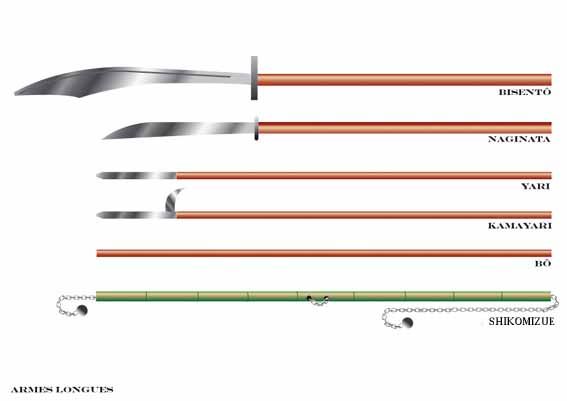
A special type of spear called
the bisento is often used. The bisento is
not a pure ninja invention;
other warriors do use it. It is most like a spear
with a scimitar attached
to the tip. Unlike a normal spear, it may both
thrust and cut. The cost
of the bisento is 12 gold pieces.
The ninja also used variations of staff weapons.
The shikomi-zue is
basically a sword staff. It is a staff with a concealed sword blade that
may be quickly extended. The cost of the
shikomi-zue is 5 pieces
of silver plus 1 week to assemble it after the staff
and a short sword are acquired.
Staves also had small missiles
attached to one end. These missiles
may be pellets or darts.
They could be sent at an enemy by flicking the
staff.
Ninja also use a device called
a poison water gun. The main use of
this weapon is to blind
enemies. It consists of a hollow wooden bamboo
tube about 1½ feet
long. The tube is open at one end and has a tiny hole
at the other end. A small
piece of cloth may be used to close it. A
wooden plunger small enough
to fit into the open end is used. A cloth is
wrapped around it to make
a tight fit. When the weapon is used the
plunger is forced into the
tube, causing a spray of water to shoot out of
the hole. The weapon has
a maximum effective range of 60 feet. The
spray is in the shape of
a triangle 60 feet high and 10 feet across at the
base. The ammunition used
is powdered iron and dye suspended in
water. A skin-contact poison
may be used, but then the weapon user is
in extreme danger. The main
effect is to blind eyes. Allow a saving throw
versus poison to see if
this happens. It takes 1-12 melee rounds to clear
the eyes. The cost of this
weapon is 5 silver pieces and 4 days.
A cannon may also
be used. The cannon is a hollow wooden tube of
about 8 inches outside diameter
and 6 inches inside diameter. The tube
is about 30 inches long.
It fires a spherical metal projectile about 60 feet
in a low, flat trajectory.
It may hit more than one target when fired. The
ninja could fire it while
holding it in his hands standing up. The tube may
be used no more than three
times. It takes 2 gold pieces and one week to
make the tube. It takes
10 gold pieces and one week to make each
projectile. It takes 20
gold pieces and one week to make the explosive to
fire the cannon once.
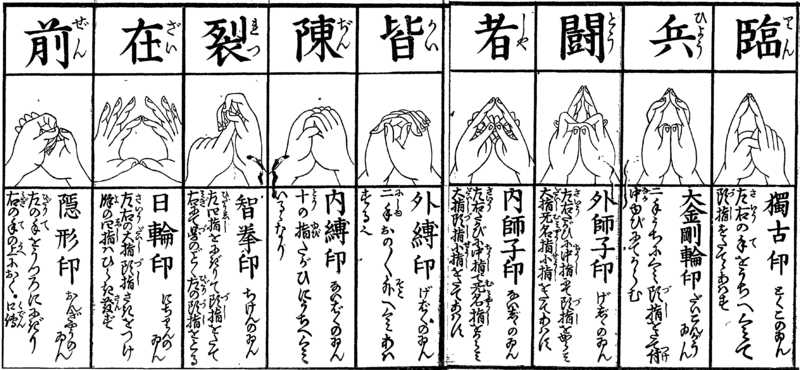
The art of kuji-kiri
is a strange skill. It consists of making strange,
almost magical, passes and
signs with the fingers. These signs are not
magical. They act to restore
the ninja’s morale and self-confidence,
make better decisions, and
to entrance one’s enemies. The entrancing
affects non-ninja only.
A non-ninja who looks at these signs being made
becomes semi-entranced for
a short period of time with no lingering
memory of having been semi-entranced.
In simple terms, the non-ninja
becomes insensitive to the
ninja’s presence. A saving throw versus the
sign is allowed to a non-ninja.
If the save is made, there is no effect. A
ninja must concentrate while
making the sign.
To be allowed a save, the
victim must be aware that a sign is being
made and he must attempt
to look away. No save is allowed on the first
exposure to these signs.
When an attempt to break
the gaze is made, a number from 3-18 is
generated (3d6). As a high
ego or strength of mind is needed to look
away, the save is made if
less than either the intelligence or wisdom is
generated. Each time the
character has been exposed to these signs in
the past subtract 2 from
the number generated. Note that the ninja is not
gazing at his victim.
Ninja Weapons
| Weapon | 2 | 3 | 4 | 5 | 6 | 7 | 8 | 9 | D | E | LD | LDE |
| Metal claws | -6 | -4 | -5 | -3 | -2 | 0 | -2 | 0 | 1-4+1 | 1-4+1 | 1-4+1 | 1-4+1 |
| Hairpins <+ or -?> | 7 | 6 | 5 | 4 | 3 | 2 | 1 | 0 | 1-6 | 1-8 | 1-6 | 1-8 |
| Bisento | -1 | 0 | 0 | 0 | 1 | 1 | 1 | 2 | - | - | - | - |
| throw, thrust | ^ | ^ | ^ | ^ | ^ | ^ | ^ | ^ | 1-8 | 2-12 | 1-10 | 2-16 |
| thrust versus charge | ^ | ^ | ^ | ^ | ^ | ^ | ^ | ^ | 1-10 | 2-16 | 1-12 | 2-16 |
| set versus charge | ^ | ^ | ^ | ^ | ^ | ^ | ^ | ^ | 1-12 | 2-12 | 2-16 | 2-20 |
| Shikomi-zue | -3 | -3 | -1 | 0 | 0 | 2 | 1 | 1 | 1-6 | 1-8 | 1-6 | 1-8 |
| stave | -3 | -3 | -1 | 0 | 0 | 2 | 1 | 1 | 1-6 | 1-8 | 1-6 | 1-8 |
| sword | -1 | 0 | 0 | 0 | 1 | 1 | 1 | 2 | 1-8 | 1-10 | 1-12 | 2-14 |
| Stave dart | -3 | -2 | 0 | 0 | 1 | 2 | 1 | 3 | 1-4 | 2-5 | 0-2 | 1-4 |
| (1.5) | -5 | -3 | -1 | -1 | 0 | 1 | 1 | 2 | ^ | ^ | ^ | ^ |
| - | -7 | -5 | -4 | -3 | 0 | 0 | 0 | 0 | ^ | ^ | ^ | ^ |
| Cannon (6) | 1 | 1 | 0 | 0 | -1 | -1 | -2 | -2 | 1-10 | 1-12 | 1-10 | 1-12 |
| - | 0 | 0 | -1 | -1 | -2 | -2 | -3 | -3 | ^ | ^ | ^ | ^ |
| - | -1 | -1 | -2 | -2 | -3 | -3 | -4 | 4<?> | ^ | ^ | ^ | ^ |
| Poison water gun (6) | 10 | 9 | 8 | 7 | 6 | 5 | 4 | 3 | * | * | * | * |
| - | 9 | 8 | 7 | 6 | 5 | 4 | 3 | 2 | ^ | ^ | ^ | ^ |
| - | 8 | 7 | 6 | 5 | 4 | 3 | 2 | 1 | ^ | ^ | ^ | ^ |
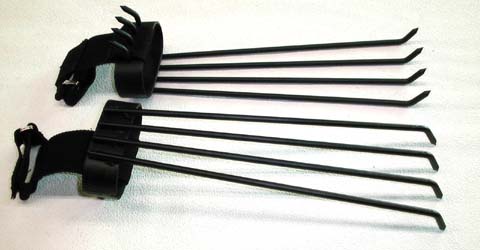
There is an improved version
of the nekade, often called
cat’s claws. This version
is made of metal. It causes +1 on damage in a
fight. It also requires
+1 on being hit if a shield is not being used. This is
because this metal version,
the tekagi, can stop a sword blow without
taking injury. The tekagi
costs triple the cost of the nekade. It may not be
drawn until after the nekade
is drawn. It has the same benefit in climbing
as the nekade.
The sandals of the
ninja were very special. The sole of the sandal
could be removed and changed.
There were two types of soles used.
One gave good traction,
and the other allowed a more silent step. Each
type of sole costs one piece
of gold and one week to make a pair. The
sandal basis has the same
cost. Both types of sandal soles come under
the same draw.
The ninja wear armor
at times. They know how to pad chainmail so
that the mail is silent
without adding extra encumbrance problems. The
mail was normally worn under
outer robes. This tool draw gives knowledge on how to pad mail to be silent
without adding extra encumbrance.
The ninja also studies the
triparte art of sacchi-jitsu. Each part of this
art constitutes one draw.
The mastery of all three parts enables the ninja
to sense who or what will
be the victor in any contest.
Satten-jitsu is the
art of being “air aware.” It gives the ability to sense
what the weather forecast
will be in the short term, not more than a few
days. It also gives a feeling
of what weather is suitable for different
activities.
Sacchi-jitsu is also
used to refer to the art of being “earth aware.”
This skill gives the ninja
sensitivity to the terrain he is in. He is aware of
which places are good for
ambushes. He is aware of how to use the
terrain to good advantage.
Santsun-jitsu is the
art of being “man aware.”
This skill gives awareness
of human weak points. It tells how to judge character and intentions. It
will work on any creature with a humanoid upper body. It tells
how to best manipulate and
appeal to people.
E q u i p m e n t : The ninja has a wide variety of illumination equipment that he may make.
The mizu-taimatsu is a torch that will burn in the rain.
The tanagokoro is
a small torch that can be held in the palm. It is so
small that the flame/light
may be concealed by one hand. It is used for
unobtrusive, short-range
work.
The ninsokudai is
an “L”-shaped candle which may be hooked to
walls and trees.
The costs of these items
are the same as for ordinary torches and
candles.
The ukidaru is a device
used to walk across water. It consists of two
large pots which are placed
over the feet as small boats. It costs 1 gold
piece and three days to
make one.
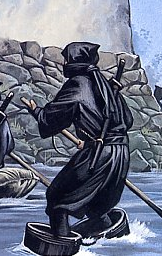
As the kama ikada may be
bulky to use, the kyobako-fune is often
used. It resembles a fur-covered
wooden chest which is light and easy to
transport. It costs the
same as an ordinary chest The fur acts as waterproofing.
The mizukaki are flippers
worn while swimming. It costs 2 days and
one gold piece to make a
pair.
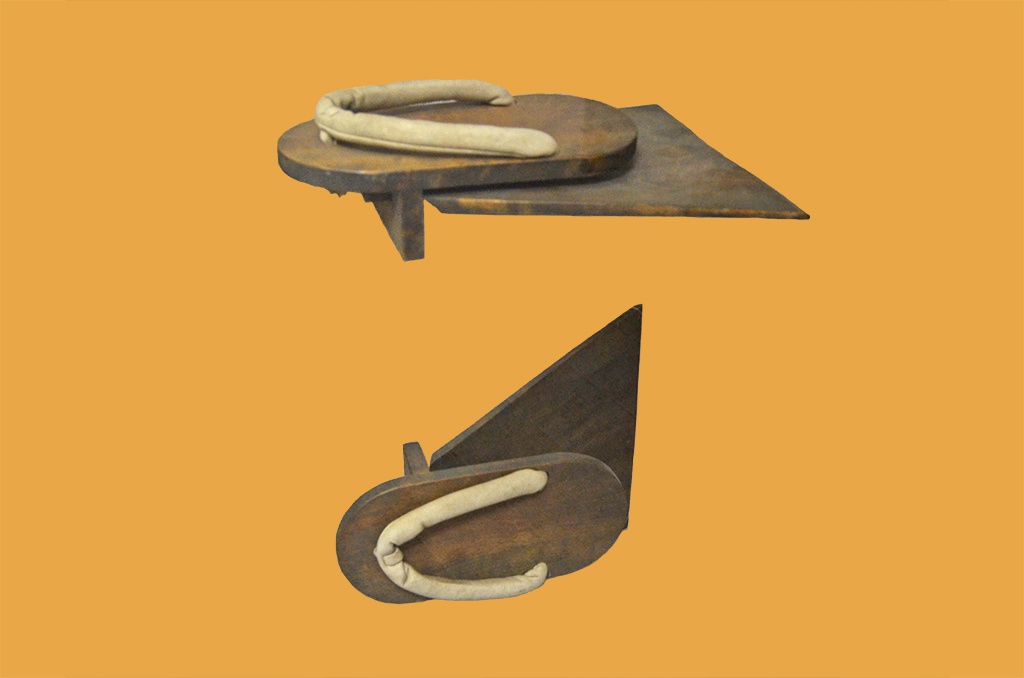
The ninja could also modify
his sandals so that he could walk on ice.
The change consists of putting
blades under the sandals. It costs one
piece of gold and one week
to make a pair.
The ninja are expert high
jumpers. They are often able to jump at
least their body height.
This is in addition to the ninja basic kit.
The ninja are expert in forging all kinds of documents.
The doka is a small
heating device which ninja use. It is a metal shell
containing burning coals.
It can be used to set off explosives. It costs 1
gold piece and 2 weeks to
make one.
Smoke bombs are often
used. They are not weapons. The bomb
gives off smoke for 1-6
turns. The smoke tends to form a sphere with a
radius expanding by 5 feet
every turn. It will then dissipate normally
when the bomb bums out.
Each bomb requires 4 days and 5 gold
pieces to make.
Rocket arrows are
sometimes used. They are very inaccurate. They
are minus 6 to hit with
respect to the short bow. If the arrow misses, it will
land 4-48 feet away from
where it was aimed. The arrow may be
explosive. It is usually
a signaling device. It is a rocket-powered arrow.
Fired from a bow, it has
a range of 150 feet. It costs 2 weeks and 10 gold
pieces to make one.
P
o i s o n s : There are six more types of poisons that
may be made.
Each draw of one of these
counts as a regular poison draw.
1) May be chosen at any level:
a) Gyokuro
This is a poison that causes slow death. It is administered in a
liquid form. If the victim is ill, it causes death in a few days. If the
victim is healthy, it causes a slow wasting resulting in death after
not more than 70 days. This poison is handled as an ordinary
ninja poison. It accumulates levels but does not cause physical
injuries.
b) Ninja also used dung and blood as a poison.
This mix causes almost instant infection, leading to lockjaw and
death.
c) Ninja also used itching powder.
d) Poisons b and c do not have levels.
2) May
be chosen at level 4:
The ninja also make a laugh-inducing poison. The poison has almost
instant effect, is administered in food and does not have levels to
accumulate.
3) May be chosen at level
6:
The ninja
could also make a sleep-inducing poison. These poisons
have
levels and accumulate as a paralyze poison at half strength. The
poison
causes sleep for 1-12 turns. This poison comes in two forms
each
of which is a separate draw:
(a.) Same physical form as standard ninja poison;
(b.) A form which takes effect when burned.
4) May be chosen at level
8:
The ninja
could make a delayed poison that could cause temporary
insanity.
The poison is administered in food. The poison takes effect
a few
hours after being administered. It does not have levels and
does
not accumulate in the victim.
5) All of the above poisons have no effect if the save is made.
6) Healing skills:
The ninja
must be able to treat and heal himself because he is not
always
able to risk seeing a doctor. Normal sprains and bruises can
always
be treated by a ninja. The ninja is able, as his cure-poison
draw
at any level, to draw a healing skill. There are two types of
healing
skills:
(a.) He is able to learn how to treat any one disease for the draw.
The treatment will cost 10 pieces in gold for each disease healed.
This may be done once a day for each time the disease is selected.
Any disease may be selected.
(b.) He gains the ability to heal 2 points of injury a day. This
does not include injury caused by poisons. This ability is not the
same as a heal spell. Note is kept of normal healing with injury
healed by this method healing first For every 5 points of injury
healed by this method, there is a penalty of 1 on attack and defense
until it has healed normally. Also, this method will not help a
character who has less than 50% damage when this method is used.
Two points of healing are gained each time this is drawn. The healing
may be split up in any fashion desired. There is a cost for medical
supplies of 1 gold piece for each point healed. Supplies are bought
before they are needed.
Healing
skills may be drawn as the cure-poison draw at any level.
These skills do not, however,
count toward the distribution requirements on poison types.
| Weapons | Tools | Equipment | Poisons |
| 1. Bo staff | 1. Tsuba | 1. Saya | 1. Instant kill |
| 2. Ninja-to | 2. Osaku | 2. Shinobi koi | 2. Slow kill |
| 3. Sageo | 3. Tsuba-giri | 3. Shinobi kumade | 3. Delayed kill |
| 4. Nage teppo | 4. Shikoro | 4. Nekade | 4. Instant paralyze |
| 5. Sode tsutsu | 5. Kunai | 5. Mizuzutsu | 5. Slow paralyze |
| 6. Kakae ozutsu | 6. Tatami nomi | 6. Musubinawa | 6. Delayed paralyzer |
| 7. Uzume-bi | 7. Escape | 7. Neru-kawa ito | 7. Gyokuro |
| 8. Hankyu | 8. Tekagi | 8. Kama ikada | 8. Dung & blood |
| 9. Metsubishi | 9. Silent sandal | 9. Mizugomo | 9. Itching powder |
| 10. Tetsubishi | 10. Traction sandal | 10. Ukigusa | 10. Laugh inducing |
| 11. Kusarigama | 11. Armor | 11. Tablets | 11. Sleep: standard |
| 12. Kyoketsu shoge | 12. Satten-jitsu | 12. Mizu-tsimatsu | 12. Sleep: burning |
| 13. Shinobi zue | 13. Sacchi-jitsu | 13. Tanagokoro | 13. Temporary insanity |
| 14. Fukumi-bari | 14. Satsun-jitsu | 14. Ninsokudai | 14. Healing |
| 15. Dart shuriken | - | 15. Ukidaru | - |
| 16. Star shuriken | - | 16. Kyobaku-fune | - |
| 17. Whistler shuriken | - | 17. Mizukaki | - |
| 18. Claws | - | 18. Ice sandals | - |
| 19. Hairpins | - | 19. Jumping | - |
| 20. Bisento | - | 20. Forgery | - |
| 21. Shikomi-zue | - | - | - |
| 22. Dart staff | - | - | - |
| 23. Poison water gun | - | - | - |
| 24. Cannon | - | - | - |
| 25. Kuji-kiri | - | - | - |
Note: Items in italic
type are unchanged from their descriptions as listed in TD16. Items in
regular type
are altered from the form
in which they appeared in TD16, or are new items fully described in the
accompanying story.